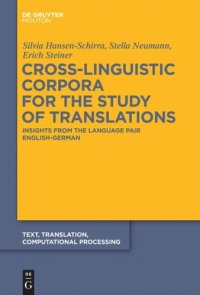
Ebook: Cross-Linguistic Corpora for the Study of Translations: Insights from the Language Pair English-German
Author: Silvia Hansen-Schirra, Stella Neumann, Erich Steiner, Oliver Culo, Sandra Hansen, Marlene Kast, Yvonne Klein, Kerstin Kunz, Karin Maksymski, Mihaela Vela
- Series: Text Translation Computational Processing [TTCP], 11
- Year: 2012
- Publisher: De Gruyter Mouton
- Language: English
- pdf
The book specifies a corpus architecture, including annotation and querying techniques, and its implementation. The corpus architecture is developed for empirical studies of translations, and beyond those for the study of texts which are inter-lingually comparable, particularly texts of similar registers. The compiled corpus, CroCo, is a resource for research and is, with some copyright restrictions, accessible to other research projects. Most of the research was undertaken as part of a DFG-Project into linguistic properties of translations. Fundamentally, this research project was a corpus-based investigation into the language pair English-German.
The long-term goal is a contribution to the study of translation as a contact variety, and beyond this to language comparison and language contact more generally with the language pair English - German as our object languages. This goal implies a thorough interest in possible specific properties of translations, and beyond this in an empirical translation theory.
The methodology developed is not restricted to the traditional exclusively system-based comparison of earlier days, where real-text excerpts or constructed examples are used as mere illustrations of assumptions and claims, but instead implements an empirical research strategy involving structured data (the sub-corpora and their relationships to each other, annotated and aligned on various theoretically motivated levels of representation), the formation of hypotheses and their operationalizations, statistics on the data, critical examinations of their significance, and interpretation against the background of system-based comparisons and other independent sources of explanation for the phenomena observed. Further applications of the resource developed in computational linguistics are outlined and evaluated.